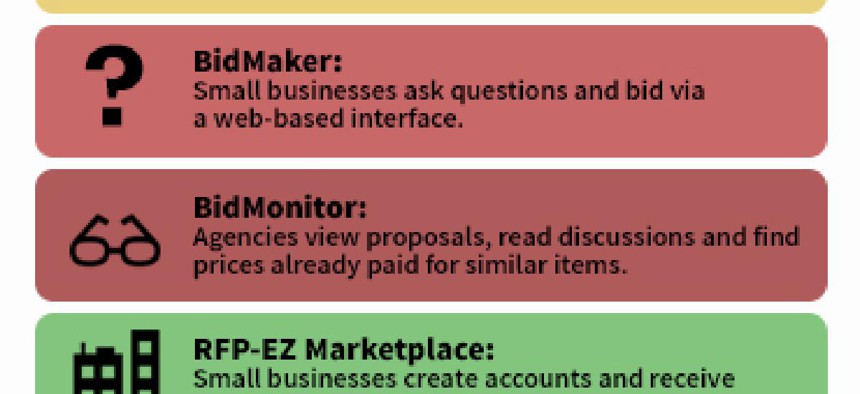Can RFP-EZ really change procurement?

This Presidential Innovations Fellows project aims to help contracting officers and small businesses alike. Now agencies will see whether it works in real life.

A signature project of the Presidential Innovation Fellows program could shift menial and time-consuming tasks from contracting officers to computers and make the federal marketplace less intimidating to small companies. The question is whether it can live up to the hype -- and whether agencies will give it a fair chance.
RFP-EZ was one of five projects the fellows program began in August 2012; its beta version launched in December. In an interview with FCW, Clay Johnson, an innovation fellow focused on RFP-EZ, said the initiative will streamline the process for certain procurements. Specifically, it is designed to make it easier for small businesses to join the federal contracting marketplace and easier for contracting and program offices to find low-cost, high-impact solutions to meet agency needs.
RFP-EZ starts with software called SOWComposer, which helps agencies draft statements of work, Johnson said. Contracting officers can use the tools to write clear SOWs through a template-driven process. They can store, reuse and even share SOWs.
For small businesses, RFP-EZ includes BidMaker, a Web-based interface that seeks to simplify the bidding process. It allows companies to respond online to a solicitation that has been created by SOWComposer rather than having to download a solicitation and develop a bid off-line.
RFP-EZ's BidMonitor component then aims to help contracting officers sort through incoming proposals generated via BidMaker. Acquisition and program officials can see a list of all current SOWs and bids, view the full text of proposals, have an online discussion about proposals that is archived for future reference, and review the prices they or other agencies have previously paid to the bidding companies.
However, the system aims to do more than facilitate individual contracts. RFP-EZ Marketplace allows small companies to register for an account, and Portfolio Browser lets agencies view profiles of small businesses that have previously performed work for the government. Profiles will include the firm's location, small-business status, prices previously paid for a vendor's products and services, or estimated pricing if the vendor is new to the federal market.
Agencies can use the beta version of RFP-EZ for relatively simple, small-value purchases from small businesses; Web design and application development projects, for instance, are already up for bid on the system. Purchases are limited to the simplified acquisition threshold (less than $150,000), and the experiment runs until May 1. Officials offered more details in a recent Federal Register notice.
Johnson and two other innovation fellows, Jed Wood and Adam Becker, developed RFP-EZ, and the government owns the resulting software. It will cost little to modify the system, which might be necessary as contracting officers get acquainted with it and make suggestions for improvements, Johnson said.
Currently, agencies and contractors go to the FedBizOpps website for the latest information on procurements, such as SOWs, notices and procurement updates. It is a central place for agencies to upload and for contractors to download documents related to solicitations.
FedBizOpps is an important advancement from the days of the paper-based procurement notification system. It has sped up the award process, but it does not simplify how companies track proposals. FedBizOpps also does not allow vendors to create electronic proposals in response to a solicitation.
Moreover, FedBizOpps is an enigma to newcomers, Johnson said, adding that it essentially has its own language: "Web developers don't call themselves 'information distribution platform providers.'"
He said he was unsure of the extent of the buy-in from the acquisition community, despite the fellows' best efforts. Younger workers, he said, are interested in the making their jobs easier, But other contracting officers see RFP-EZ as just another idea outside innovators dreamed up. (See sidebar.)
"It's a valid fear that this is just another tool," Johnson said. Over the next several months, he and his colleagues will find out if they can overcome those doubts.
Acquisition experts have questions of their own. Several warned that government officials will have to ensure that RFP-EZ does not become a way to sidestep competition for contracts. And the fact that it simplifies certain types of small projects could encourage agencies to go for what is quick rather than what is really needed.
When the project was first announced, Paul Brubaker, who was in the private sector at the time and is now director of planning and performance management at the Defense Department, said RFP-EZ could encourage a proliferation of poorly conceived mobile apps, similar to the way agencies once rushed to build websites that then went largely unused.
RFP-EZ has two impediments, said Steven Koprince, a government contracts attorney and author of "The Small-Business Guide to Government Contracts." First, it does not actually make the procurement process easier for the contracting officer or the contractor because both sides still must comply with more than 2,000 pages of acquisition rules. Second, news of the pilot project might not reach enough contracting officers or vendors to make a real impact.
Yet Ellen Murray, assistant secretary for financial resources at the Department of Health and Human Services, said she is looking forward to test-driving RFP-EZ.
She said HHS' contracting executives will see a demonstration of the project in February. They plan to share information among HHS offices and have one contracting office provide feedback on the pilot. Murray also plans to lay the groundwork required to integrate RFP-EZ into the department's acquisition process.
"HHS is interested in the RFP-EZ concept," she said. The demo "will afford us an opportunity to understand its utility and how it can be integrated into our systems and practices."
Officials will consider what the project has to offer them, Koprince agreed. "The bottom line is that I think that the RFP-EZ system will get a fair shake from both contractors and contracting officers," he said, "and we will see where that takes us."
NEXT STORY: GAO pushes new interagency contracting rules


